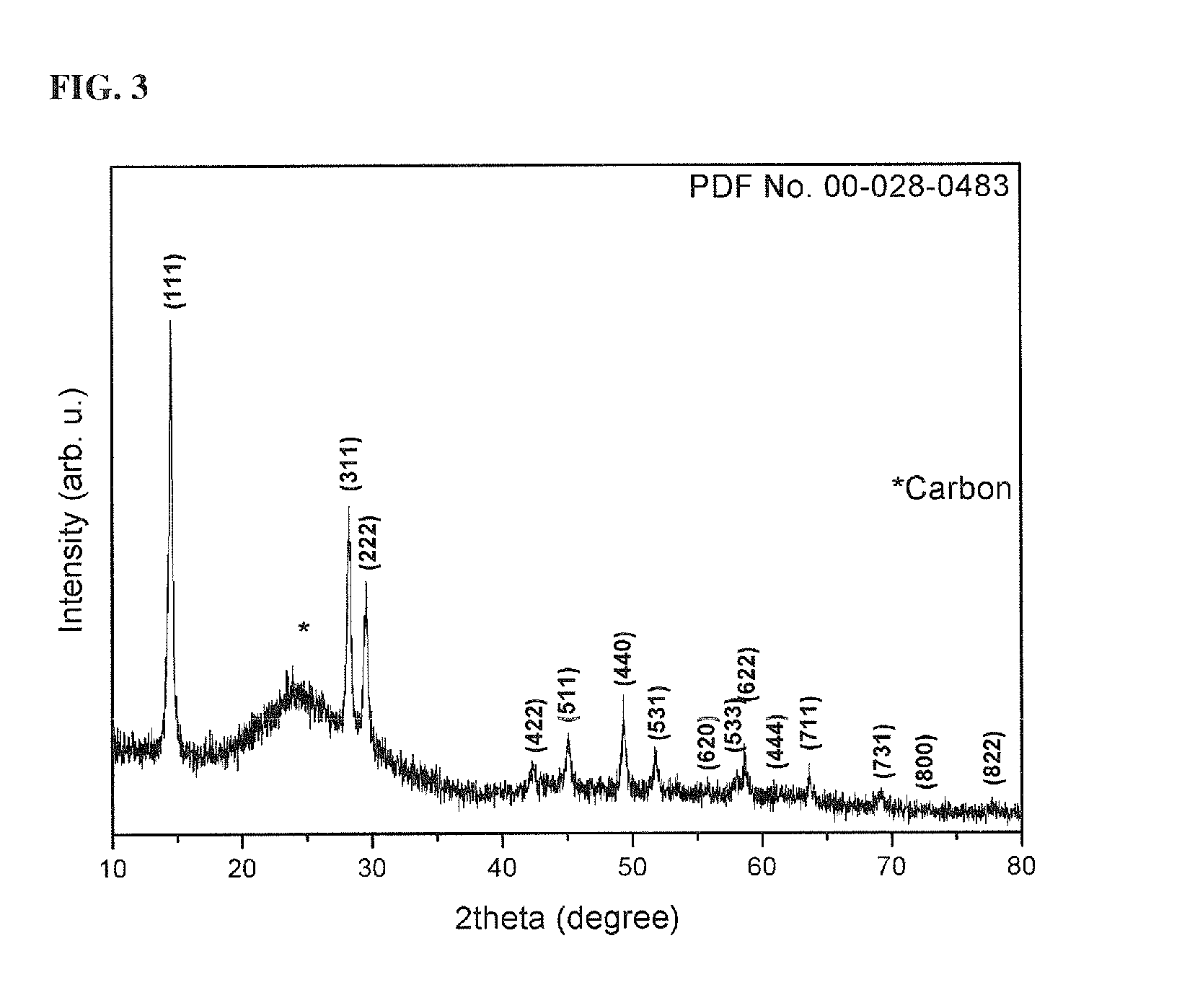Cathode active material for sodium secondary battery, method for preparing the same and sodium secondary battery employing the same
a sodium secondary battery and active material technology, applied in the direction of batteries, non-metal conductors, cell components, etc., can solve the problems of sodium secondary batteries suffering from limitations, sodium is more sensitive to air, sodium secondary batteries are difficult to prepare, etc., to achieve excellent cycle characteristics, easy preparation, and high capacity
- Summary
- Abstract
- Description
- Claims
- Application Information
AI Technical Summary
Benefits of technology
Problems solved by technology
Method used
Image
Examples
example 1-1
FeF2.5(0.5H2O)-MWNT Composite
[0078]10 mL of 1-butyl-3-methylimidazolium tetrafluoroborate (BMIMBF4, Aldrich, >98%), 1 gr of ferric nitrate (Fe(NO3)3.9H2O, Aldrich, 99.99%), and 10 wt % of multi-wall carbon nanotubes (MWNTs) with respect to the weight of the ferric nitrate were prepared.
[0079]First, the pre-weighed MWNTs were mixed with the BMIMBF4 (10 ml), and then the mixture was stirred with a magnetic bar for 1 hr to prepare a solution in which the MWNTs were uniformly dispersed.
[0080]Thereafter, the pre-weighed ferric nitrate was poured into the solution. The mixture was stirred at 50° C. for 14 hr to obtain a FeF2.5(0.5H2O)-MWNT composite.
[0081]The FeF2.5(0.5H2O)-MWNT composite was placed in a centrifuge and washed with acetone. The centrifuge was operated at 5,000 rpm for 5 min. This procedure was repeated five times to remove organic impurities formed in, the course of preparing the composite. Thereafter, the washed FeF2.5(0.5H2O)-MWNT composite was dried under vacuum at 80° ...
example 1-2
Sodium Secondary Battery Employing the FeF2.5(0.5H2O)-MWNT Composite as Cathode Active Material
[0082]The FeF2.5(0.5H2O)-MWNT composite (0.39 gr) prepared in Example 1-1, Denka black (0.195 gr) as a conductive material, and PVDF (1.2999 gr) as a binder were mixed in a weight ratio of 60:30:10. To the mixture was added NMP as an organic solvent until a uniform viscosity was obtained. The resulting mixture was prepared into a paste. Then, the paste was applied onto an aluminum foil and dried at 80° C. for 4 hr. Subsequently, the coated aluminum foil was pressed using a rolling press to produce a cathode including the FeF2.5(0.5H2O)-MWNT composite.
[0083]The cathode including the FeF2.5(0.5H2O)-MWNT composite, a polypropylene (PP) separator, and a sodium counter electrode were assembled to fabricate a half cell of a sodium secondary battery. 1 M NaClO4 was dissolved in an organic solvent of propylene carbonate (PC), ethylene carbonate (EC) and diethylene carbonate (DEC) in a ratio of 1:1...
example 2-1
FeF2.5(0.5H2O)-RGO Composite
[0084]10 mL of 1-butyl-3-methylimidazolium tetrafluoroborate (BMIMBF4, Aldrich, >98%), 1 gr of ferric nitrate (Fe(NO3)3.9H2O, Aldrich, 99.99%), and 10 wt % of reduced graphene oxide (RGO) with respect to the weight of the ferric nitrate were prepared.
[0085]First, the pre-weighed RGO was mixed with the BMIMBF4 (10 ml), and then the mixture was stirred with a magnetic bar for 1 hr to prepare a solution in which the RGO was uniformly dispersed.
[0086]Thereafter, the pre-weighed ferric nitrate was poured into the solution. The mixture was stirred at 50° C. for 14 hr to obtain a FeF2.5(0.5H2O)-RGO composite.
[0087]The FeF2.5(0.5H2O)-RGO composite was placed in a centrifuge and washed with acetone. The centrifuge was operated at 5,000 rpm for 5 min. This procedure was repeated five times to remove organic impurities formed in the course of preparing the composite. Thereafter, the washed FeF2.5(0.5H2O)-RGO composite was dried under vacuum at 80° C. for 20 hr. FIG....
PUM
 Login to View More
Login to View More Abstract
Description
Claims
Application Information
 Login to View More
Login to View More - R&D
- Intellectual Property
- Life Sciences
- Materials
- Tech Scout
- Unparalleled Data Quality
- Higher Quality Content
- 60% Fewer Hallucinations
Browse by: Latest US Patents, China's latest patents, Technical Efficacy Thesaurus, Application Domain, Technology Topic, Popular Technical Reports.
© 2025 PatSnap. All rights reserved.Legal|Privacy policy|Modern Slavery Act Transparency Statement|Sitemap|About US| Contact US: help@patsnap.com



